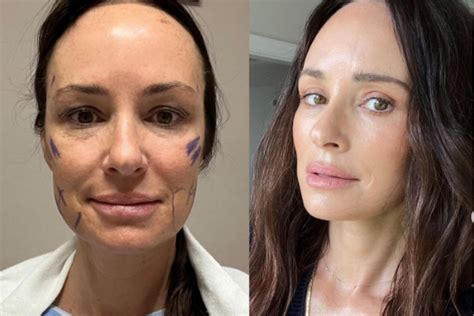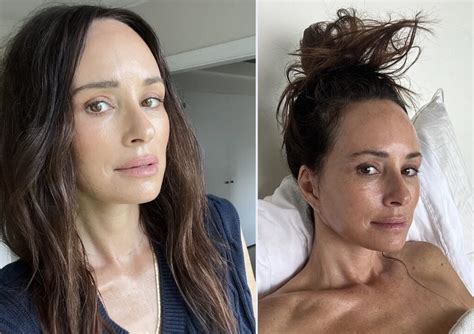
Catt Sadler, the former E! News host, has openly discussed undergoing a facelift at age 48, emphasizing transparency and self-acceptance in her journey. She shared the experience on her personal blog and podcast, “Naked With Catt Sadler,” aiming to destigmatize cosmetic procedures and encourage open conversations about aging.
Sadler decided to undergo the procedure after noticing significant changes in her appearance due to the natural aging process and the stressors of life. She explicitly chose to share her journey to combat the secrecy and shame often associated with cosmetic surgery, particularly among women in the public eye. “I am choosing radical honesty,” Sadler stated on her blog, “because that’s what feels right to me.”
The facelift, performed by Dr. Jason Diamond in Beverly Hills, addressed sagging skin and loss of volume in her face and neck. Sadler emphasized that she wanted to look like a refreshed version of herself, not an entirely different person. She meticulously documented the process, from initial consultations to post-operative recovery, providing her audience with a comprehensive and unfiltered view of the experience.
Sadler’s decision to share her facelift journey candidly has been met with both praise and criticism. Supporters commend her honesty and bravery in challenging societal norms, while critics question the message it sends about aging and beauty standards. However, Sadler remains steadfast in her belief that transparency and self-acceptance are paramount.
Sadler’s Career Background
Catt Sadler gained prominence as a television personality and entertainment reporter, primarily known for her work at E! News. Over her decade-long tenure with the network, she covered numerous red-carpet events, interviewed celebrities, and delivered entertainment news to a wide audience. Her career at E! News abruptly ended in 2017 when she left the network due to a significant pay disparity compared to her male co-host. This incident sparked a public conversation about gender equality in the entertainment industry and highlighted the challenges women face in achieving equal pay for equal work.
Following her departure from E! News, Sadler ventured into various entrepreneurial and creative endeavors. She launched her personal blog and podcast, “Naked With Catt Sadler,” where she discusses a wide range of topics, including relationships, personal growth, and current events. The podcast has provided her with a platform to share her experiences and perspectives on issues she is passionate about.
Sadler has also remained active in the media landscape, making appearances on other television programs and engaging in public speaking events. She has become an advocate for women’s rights and gender equality, using her platform to raise awareness and promote positive change. Her willingness to speak out on important issues has earned her respect and admiration from many.
Beyond her media career, Sadler has also been involved in philanthropic work. She has supported various charitable organizations and causes, demonstrating her commitment to giving back to the community. Her efforts to make a positive impact on the world reflect her values and her desire to use her influence for good.
Reasons for Choosing a Facelift
Sadler’s decision to undergo a facelift stemmed from a combination of factors, including her personal feelings about aging, the demands of her profession, and her desire to maintain a youthful appearance. She openly admitted that she noticed significant changes in her face and neck over time, which affected her self-confidence. “I just turned 48, and honestly, the mirror was starting to bum me out,” she wrote.
The entertainment industry often places a high value on appearance, and Sadler acknowledged that this influenced her decision. As a television personality, she felt pressure to maintain a certain image, and she believed that a facelift would help her stay competitive in her field. “I work in an industry where, let’s be honest, it’s about the way you look,” she said.
Sadler also emphasized that her decision was a personal one, driven by her own desire to feel good about herself. She wanted to look like a refreshed and rejuvenated version of herself, not an entirely different person. “I wanted to do something for myself,” she explained. “I wanted to feel confident and happy when I looked in the mirror.”
Furthermore, Sadler was motivated by the opportunity to share her experience with others. She wanted to destigmatize cosmetic procedures and encourage open conversations about aging. By being transparent about her facelift, she hoped to empower other women to make informed decisions about their own bodies and appearances. “I want to be part of the conversation,” she said. “I want to help women feel comfortable talking about these things.”
Choosing Dr. Jason Diamond
Catt Sadler’s choice of Dr. Jason Diamond for her facelift was based on his reputation, expertise, and aesthetic philosophy. Diamond is a renowned facial plastic surgeon in Beverly Hills, known for his natural-looking results and his commitment to patient care. Sadler had been following Diamond’s work for some time and was impressed by his skill and artistry. “I had been stalking Dr. Diamond on Instagram for years,” she confessed.
One of the primary reasons Sadler chose Diamond was his focus on creating subtle and harmonious changes that enhance a person’s natural features. She didn’t want to look drastically different, but rather a refreshed version of herself. Diamond’s approach aligned perfectly with her goals. “I wanted someone who was going to make me look like myself, but maybe five or ten years ago,” she explained.
Sadler also appreciated Diamond’s emphasis on thorough consultations and personalized treatment plans. He took the time to understand her specific concerns and goals, and he developed a surgical plan that was tailored to her individual needs. “He really listened to me,” she said. “He understood what I wanted, and he made me feel comfortable throughout the entire process.”
In addition to his technical skills, Sadler was also drawn to Diamond’s warm and compassionate demeanor. She felt that he genuinely cared about her well-being, and she trusted him to deliver the best possible results. “He’s not only a brilliant surgeon, but he’s also a kind and caring person,” she said. “I knew I was in good hands.”
The Surgical Procedure
The facelift procedure performed on Catt Sadler by Dr. Jason Diamond was a customized surgery designed to address her specific concerns and goals. While the exact details of the procedure are confidential, it likely involved a combination of techniques to lift and tighten the skin and underlying tissues of her face and neck.
A facelift typically involves making incisions around the ears and hairline, allowing the surgeon to access the underlying facial structures. The surgeon then lifts and repositions the skin and tissues, removes excess skin, and tightens the muscles. In some cases, fat grafting may also be performed to restore volume to areas that have lost fullness over time.
Dr. Diamond likely used a combination of traditional facelift techniques and more advanced methods to achieve Sadler’s desired results. He may have incorporated techniques such as a deep plane facelift, which involves releasing the deeper layers of facial tissue to provide a more comprehensive and long-lasting lift. He also may have used fat grafting to restore volume to her cheeks and temples, creating a more youthful and balanced appearance.
The procedure typically takes several hours to complete and is performed under general anesthesia. After the surgery, patients can expect to experience some swelling, bruising, and discomfort. However, these side effects usually subside within a few weeks.
Recovery and Results
The recovery process following a facelift can vary from person to person, but it generally involves several weeks of rest and careful attention to post-operative instructions. Catt Sadler documented her recovery journey on her blog and podcast, providing her audience with a realistic and unfiltered view of the experience.
In the initial days after surgery, Sadler experienced swelling, bruising, and discomfort. She followed Dr. Diamond’s instructions carefully, taking pain medication as needed and applying cold compresses to reduce swelling. She also wore a compression bandage to support her face and neck. “The first few days were definitely the hardest,” she admitted. “I was swollen and bruised, and I couldn’t do much.”
As the swelling and bruising subsided, Sadler began to see the initial results of her facelift. Her face appeared more lifted and toned, and her jawline was more defined. However, she cautioned that it takes several months for the final results to become fully visible. “It’s a marathon, not a sprint,” she said. “You have to be patient and trust the process.”
After several months, Sadler was thrilled with the final results of her facelift. She felt that she looked like a refreshed and rejuvenated version of herself, and she was pleased with the natural-looking outcome. “I’m so happy with the results,” she exclaimed. “I feel like I look like myself, but younger and more rested.”
Transparency and Honesty
Catt Sadler’s decision to be transparent and honest about her facelift was a deliberate choice aimed at destigmatizing cosmetic procedures and promoting open conversations about aging. She believed that by sharing her experience, she could help other women feel more comfortable talking about their own bodies and appearances. “I wanted to be part of the solution,” she said. “I wanted to help break down the stigma surrounding cosmetic surgery.”
Sadler openly discussed her reasons for getting a facelift, the details of the procedure, and her recovery process. She shared photos and videos of herself at various stages of the journey, providing her audience with an unfiltered view of the experience. “I wanted to show people what it’s really like,” she explained. “I didn’t want to sugarcoat anything.”
Her transparency was met with both praise and criticism. Some people applauded her bravery and honesty, while others questioned the message it sent about aging and beauty standards. However, Sadler remained steadfast in her belief that transparency was the right approach. “I knew that not everyone would agree with my decision,” she said. “But I felt that it was important to be true to myself and to share my experience in an honest and authentic way.”
Impact and Reception
Catt Sadler’s openness about her facelift has had a significant impact on the conversation surrounding cosmetic procedures and aging. Her story has been widely covered in the media, sparking discussions about beauty standards, self-acceptance, and the pressure to maintain a youthful appearance.
Many people have praised Sadler for her honesty and bravery, commending her for challenging societal norms and promoting transparency. They believe that her story has helped to normalize cosmetic surgery and encourage women to make informed decisions about their own bodies. “Catt Sadler is a role model,” one fan wrote on social media. “She’s showing us that it’s okay to be honest about our choices and to do what makes us feel good.”
However, others have criticized Sadler for reinforcing unrealistic beauty standards and promoting the idea that women need to undergo cosmetic surgery to feel confident and beautiful. They argue that her story sends a negative message to young women, suggesting that aging is something to be feared and avoided. “I’m disappointed that Catt Sadler chose to get a facelift,” one critic wrote. “I think it sends the wrong message to young women.”
Despite the criticism, Sadler remains committed to her message of transparency and self-acceptance. She believes that it’s important for women to have open and honest conversations about aging and beauty, and she hopes that her story will inspire others to do the same. “I’m not telling anyone what to do,” she said. “I’m just sharing my experience and hoping that it will help others feel more empowered to make their own choices.”
Broader Context: Cosmetic Surgery Trends
Catt Sadler’s decision to undergo a facelift and openly discuss it aligns with broader trends in the cosmetic surgery industry. The demand for cosmetic procedures has been steadily increasing in recent years, driven by factors such as an aging population, advancements in surgical techniques, and the influence of social media.
According to the American Society of Plastic Surgeons, nearly 18 million cosmetic procedures were performed in the United States in 2020. Facelifts are among the most popular surgical procedures, with over 100,000 performed annually. The average age of facelift patients is between 40 and 60, although people of all ages are increasingly seeking cosmetic enhancements.
The rise in cosmetic surgery has also been accompanied by a growing acceptance of these procedures in society. While there was once a stigma associated with cosmetic surgery, it is now more widely viewed as a personal choice. Many people are open about their experiences with cosmetic surgery, sharing their stories on social media and in the media.
However, the increased popularity of cosmetic surgery has also raised concerns about unrealistic beauty standards and the pressure to conform to societal expectations. Some critics argue that the cosmetic surgery industry preys on people’s insecurities and promotes the idea that physical appearance is the most important factor in determining self-worth.
Catt Sadler’s case is a complex example of these trends. While she embraces transparency and honesty, her decision also highlights the pressure faced by individuals in the entertainment industry to maintain a youthful appearance. Her experience underscores the need for a balanced perspective, one that acknowledges the personal autonomy in making cosmetic choices while also promoting body positivity and self-acceptance at all ages.
Ethical Considerations in Cosmetic Surgery
The field of cosmetic surgery raises several ethical considerations, particularly concerning patient autonomy, informed consent, and the potential for exploitation. Surgeons have a responsibility to ensure that their patients are making informed decisions and are not being unduly influenced by external factors.
Informed consent is a crucial aspect of cosmetic surgery. Patients should be provided with comprehensive information about the risks, benefits, and alternatives to the procedure, as well as the expected outcomes and recovery process. They should also be given the opportunity to ask questions and express any concerns they may have.
Surgeons also have a responsibility to assess the psychological well-being of their patients. Cosmetic surgery should not be used as a means of addressing underlying psychological issues, such as body dysmorphic disorder or depression. In such cases, patients should be referred to a mental health professional for appropriate treatment.
Another ethical consideration is the potential for exploitation. Surgeons should not take advantage of patients’ vulnerabilities or insecurities to persuade them to undergo unnecessary or inappropriate procedures. They should also be transparent about their fees and avoid charging excessive amounts.
Catt Sadler’s case highlights the importance of these ethical considerations. Her surgeon, Dr. Jason Diamond, likely took steps to ensure that she was making an informed decision and that her expectations were realistic. He also likely assessed her psychological well-being to ensure that she was a suitable candidate for the procedure.
Ultimately, the decision to undergo cosmetic surgery is a personal one. However, it is important for patients to be aware of the ethical considerations involved and to choose a surgeon who is committed to providing safe and ethical care.
FAQ Section
1. Why did Catt Sadler decide to get a facelift?
Catt Sadler decided to get a facelift at age 48 primarily because she noticed changes in her appearance that affected her self-confidence. She also cited the pressures of working in the entertainment industry, where appearance is highly valued, and a personal desire to feel like a refreshed version of herself. As she stated, “I just turned 48, and honestly, the mirror was starting to bum me out,” indicating her desire to address signs of aging that bothered her.
2. Why was Catt Sadler so open about her facelift experience?
Sadler chose to be transparent about her facelift to destigmatize cosmetic procedures and encourage open conversations about aging. She wanted to combat the secrecy and shame often associated with cosmetic surgery, particularly among women in the public eye. By sharing her journey, she hoped to empower other women to make informed decisions about their bodies and appearances. She emphasized “radical honesty” as the motivation behind her openness.
3. Who was the surgeon that performed Catt Sadler’s facelift, and why did she choose him?
Dr. Jason Diamond, a renowned facial plastic surgeon in Beverly Hills, performed Catt Sadler’s facelift. She chose him based on his reputation, expertise, and aesthetic philosophy of creating natural-looking results. Sadler had followed Diamond’s work for years and was impressed by his skill and his emphasis on personalized treatment plans. “I had been stalking Dr. Diamond on Instagram for years,” she confessed, indicating her long-standing interest in his work.
4. What were some of the reactions to Catt Sadler’s decision to get a facelift and share her experience?
Sadler’s decision to undergo a facelift and openly discuss it was met with mixed reactions. Supporters praised her honesty and bravery in challenging societal norms and destigmatizing cosmetic surgery. Critics, however, questioned the message it sends about aging and beauty standards, arguing that it reinforces unrealistic expectations. Despite the criticism, Sadler remained committed to promoting transparency and self-acceptance.
5. What kind of facelift procedure did Catt Sadler undergo?
While the specific details of Catt Sadler’s facelift procedure are confidential, it likely involved a combination of techniques to lift and tighten the skin and underlying tissues of her face and neck. It might have included a deep plane facelift, which releases deeper layers of facial tissue for a more comprehensive lift, and fat grafting to restore volume.









